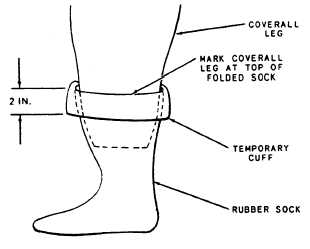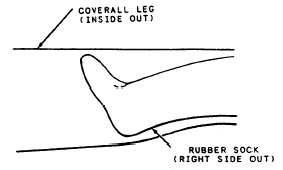Figure 4-9.—Fitting the SRU-25/P rubber socks.
top of the folded socks (fig. 4-9). Have the aircrew
member take off the coveralls. Remove the top
2 inches of the socks with a pair of sharp scissors.
5. Remove excess material from the coverall
leg by cutting a line 1 inch below the mark that
was applied in step 4. Ensure the leg is cut
perpendicular to the lengthwise direction of the
leg. Make your alignment marks at the front of
the coverall legs and socks to ensure the socks will
be properly aligned with the legs during the
attachment process.
6. Turn the coveralls inside out and lay them
flat, facing up.
NOTE: When you attach the socks to the
coveralls, the right sock is on the right leg
and the left sock is on the left leg.
7. Insert the sock into the leg opening, so that
the right sides of the sock and coverall leg are
facing each other, and the toe is pointing up
(toward the front) (fig. 4-10).
Figure 4-10.—Attaching the rubber sock to the coverall leg.
8. Beginning at the front of the leg, make
sure the alignment marks are matched. Then
attach the sock with one row of stitches, one-
fourth inch from the cut edges, five to seven
stitches per inch, using nylon size E thread.
Overlap the stitching one-half inch. Do not
backstitch.
9. Fold the cut edges of the seam over the
sock. Make the fold as near the stitch line as
possible. Apply one layer of 1 1/2-inch seam tape
over the seam, keeping the stitch line and the cut
edges as nearly centered under the tape as possible.
Overlap the ends of the seam tape 1 inch.
10. Additional information on maintenance
procedures, inspection cycles, and test equipment
for antiexposure assemblies is covered in the
Aircrew Personal Protective Equipment Manual,
NAVAIR 13-1-6.7.
ANTI-G GARMENTS
Although there is no limit to the speed a
human can endure in straight and level flight in
an aircraft, changing speed or direction can
produce inertia to which the body has a sharply
limited tolerance. In the case of extreme stresses
exerted by forces of the type met in seat ejection,
ditching, or parachute opening shock, the short
duration of the force restricts its effects. However,
changing the direction of flight often produces
stress forces equal to several times the normal
value of gravity for periods longer than a second.
These forces can have dangerous effects.
At 5 g’s (five times the force of gravity), the
pilot’s body is exposed to a force that increases
its weight and that of its components five times.
This increased weight has many effects. The pilot
is pushed down into his seat. His arms and legs
feel like lead, and manipulation of the controls
becomes more difficult. In addition, the extra
weight of the internal organs causes abdominal
and chest discomfort. Most important, however,
is the effect on the circulatory system.
At 5 g’s the pressure exerted by the column
of blood between the head and the heart becomes
just about equal to the blood pressure in the
arteries. As a result, the pressure supplied by the
heart is not great enough to pump an adequate
supply of blood to the head.
To counteract these effects, the pressure in the
arteries must be increased above the heart level.
At the same time, distended vessels and tissue and
fluid spaces in the regions below the heart must
4-2



